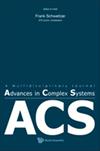Spatial Scale Effects in COVID-19 Spread Models
IF 1
4区 数学
Q4 MATHEMATICS, INTERDISCIPLINARY APPLICATIONS
引用次数: 2
Abstract
The COVID-19 pandemic has highlighted epidemiological models as important forecasting methods and planning strategies, with studies conducted using a wide variety of analytical and computational techniques. Knowing that more pandemic episodes may occur, it is essential that epidemiological modeling present increasingly credible results. From this perspective, this paper aims to highlight the influence of spatial distribution on an epidemic dynamic, using agent-based modeling. To calibrate the behavioral profile of the population, data was taken on mobility, population pyramid, individual behavior and government policies of a real population during the pandemic. Two different initial spatial distribution scenarios are tested and the robustness of the infection is analyzed. Totalistic rules were designed to assess the influence of infected individuals in the vicinity of an agent, a factor that must not be ignored in modeling respiratory diseases with viruses capable of spreading by aerosols, such as SARS-CoV-2. It is shown that the scenario with nonuniform distribution of agents is much more robust, generating an epidemic process even when uniform distribution, for the same parameters, did not propagate the infection. Our results also suggest that herd immunity is attained in different levels of recovered individuals, showing higher values in denser regions. In conclusion, it is reinforced that the nonuniform feature of the spatial distribution of individuals plays a key role in the infection dynamics and should receive more attention when building epidemiological models.COVID-19传播模型的空间尺度效应
2019冠状病毒病大流行凸显了流行病学模型作为重要预测方法和规划策略的重要性,研究使用了各种分析和计算技术。鉴于可能会发生更多的大流行事件,流行病学模型必须提供越来越可信的结果。从这个角度来看,本文旨在利用基于智能体的建模来突出空间分布对流行病动态的影响。为了校准人口的行为特征,采集了大流行期间真实人口的流动性、人口金字塔、个人行为和政府政策等数据。测试了两种不同的初始空间分布情况,并分析了感染的鲁棒性。设计了总体规则来评估病原体附近受感染个体的影响,这是在模拟具有能够通过气溶胶传播的病毒(如SARS-CoV-2)的呼吸道疾病时不可忽视的一个因素。结果表明,药剂非均匀分布的情形具有更强的鲁棒性,即使对于相同的参数,均匀分布并不传播感染,也会产生流行病过程。我们的研究结果还表明,在不同水平的恢复个体中实现了群体免疫,在密度较大的地区显示出更高的值。综上所述,个体空间分布的不均匀特征在感染动态中起着关键作用,在建立流行病学模型时应予以更多关注。
本文章由计算机程序翻译,如有差异,请以英文原文为准。
求助全文
约1分钟内获得全文
求助全文
来源期刊

Advances in Complex Systems
综合性期刊-数学跨学科应用
CiteScore
1.40
自引率
0.00%
发文量
121
审稿时长
6-12 weeks
期刊介绍:
Advances in Complex Systems aims to provide a unique medium of communication for multidisciplinary approaches, either empirical or theoretical, to the study of complex systems. The latter are seen as systems comprised of multiple interacting components, or agents. Nonlinear feedback processes, stochastic influences, specific conditions for the supply of energy, matter, or information may lead to the emergence of new system qualities on the macroscopic scale that cannot be reduced to the dynamics of the agents. Quantitative approaches to the dynamics of complex systems have to consider a broad range of concepts, from analytical tools, statistical methods and computer simulations to distributed problem solving, learning and adaptation. This is an interdisciplinary enterprise.
 求助内容:
求助内容: 应助结果提醒方式:
应助结果提醒方式:


